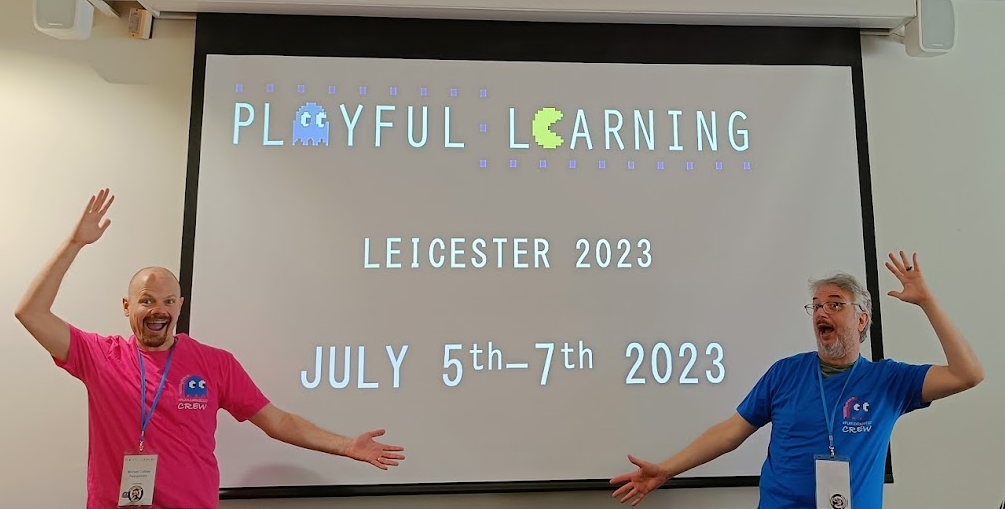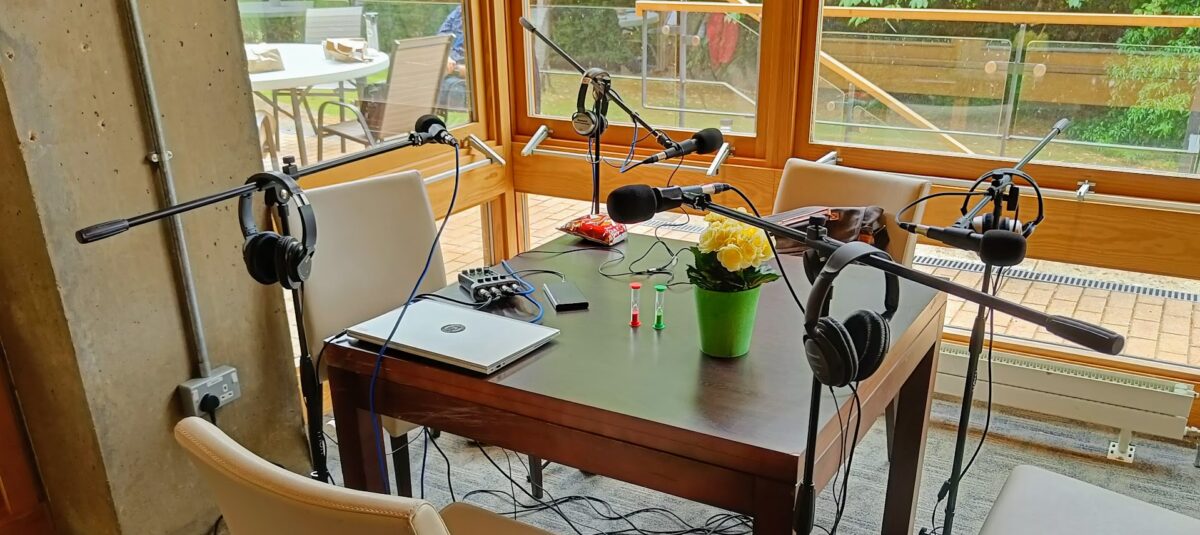It’s a few weeks after the Playful Learning conference, and even after a bit of time to decompress I’m still a buzzing, overstimulated mess. And you know what? I’d do it all again in a heartbeat.
In this article and accompanying podcast, I’d like to share my take on the conference: my impressions, my takeaways, my general experience. It’s been a highlight of both my professional and podcasting career to date, and I’m hoping that through the process of reflecting on it I’ll identify some of the reasons why it resonated with me, and how I can translate the experience into my practice.
I attended the conference both as an Open University Learning Designer, and under the banner of ‘Pedagodzilla’ – the education versus pop culture podcast I produce with Dr Mark Childs as a fun way of discussing pedagogy and our love of geeky pop culture.
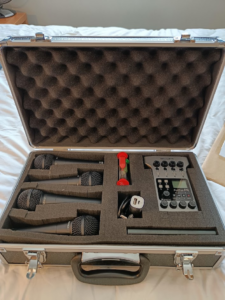
Alongside this article, I’ve released a ‘conference-in-a-pod’ podcast digest episode that pulls my reflections together with recordings with organisers, attendees, presenters and keynotes into a single (very chunky) podcast episode. If you weren’t able to make the conference yourself then hopefully you’ll find this the next best thing. It’s available on the Pedagodzilla feed, downloadable or can be listened to now through the media player below:
Day 1
Rules are there to be questioned
The conference kicked off with Dr Elliott Spaeth’s rousing keynote, ‘How can educators play fair by throwing out the rules?’. His take on being playful in a learning context really stuck with me throughout, reflecting on and questioning the rules that we have in a playful way, and questioning the assumptions that rules are derived from. The assumptions educators can have around either ideal, or implied students can in turn lead to the construction of an ‘obstacle course’ of rules (I loved this metaphor) that may challenge those idealised students, but completely floor those outside of the assumptions. Neurodivergent students, students with different lived experience, and so on. Rules should be like pens. Give them a good scribble, and if the intervention and impact aren’t working then chuck them out.
Elliott extolls the benefits far better than I can of course, have a listen to the interview with him if you’d like to get a more comprehensive, and coherent take on it.
The reflections that percolated over the following days around this, were twofold. One was that I’d seen some of this reflected in my own practice over the last year. I’d made a personal choice to be a bit more playful for my own sanity – which has not only improved my work, but also I think my interactions with my colleagues. This leads me to wonder about the rules and assumptions in my own practice – unspoken rules around organisational hierarchy, professional interactions and expectations. Something I think I’ll be challenging teams to do in my own design work is considering any projected rules and assumptions they have about distance learning, and then seeing where there’s space to be a little more playful around those.
Pedagodzilla on tour
Following the keynote, and a mad dash to College Court, I got the Pedagodzilla recording station set up in a cosy corner of the café and started recording like crazy. The format for these initial drop-in recordings was a short, structured conversation, asking attendees and presenters to describe a game they were passionate about and identify what factors fuelled the passion. We would then go on to discuss their learning and teaching practice, seeing if there were any links between their personal approach and the characteristics of their favourite games.

It was initially intended as an icebreaker, and a way to loosen people up before an informal chat about their practice. Once we got into it though, we found that some people had some quite profound links between their personal drivers and how they approached education. There’s likely a deeper piece of work to look into that, but for now it’s a lovely collection of 10-15 minute chats with some interesting and articulate folk, which I’m very much looking forward to sharing. In addition to these, we recorded a series of broader interviews and pieces of edu-podcaster research. There’s over eight hours’ worth in total, which we’ll edit and publish over the next few months. I can’t wait to share it all!
Exquisite Corpse
With recordings under my belt, and a lunch hastily snarfed, it was off to the first of many parallel sessions. I started with Beatriz Acevedo and Andrew Middleton’s fab session on Playing Exquisite Corpse, and how they’ve adapted the game into a conversational framework that they use as a pre-work warm-up podcast. The framework itself is simple, playful and quite effective as a way to explore topics. In a baton passing way it asks a group to:
- Create a head (the initial preposition)
- Add a body (expand the preposition)
- Draw arms (take the preposition in divergent directions to see where it goes. It might have 2 arms, it might have twelve)
- Attempt to draw the legs (based on the discussion, ‘does it have legs?’ Does the preposition have merit, and if so what can we do with or about it?)
As a framework, it’s fun, democratic, accessible and, as demonstrated in the session, a good way of taking an absurd idea and having a serious action-focused discussion around it. It’s something I’ll try and use myself as a way to discuss design challenges next time a particularly thorny one crops up with a module team.
Mandible action
After that it was over to Claire Timmins’s session on Making Anatomy Fun and interesting, where she demonstrated the range of methods she’d used to engage students around the subject of the anatomy of speech production, including crafts and Minecraft Education. We were given a range of paper cut and craft handouts to build our own anatomical models of speech related bits of the body. While we snipped and folded away, Claire talked us through some of the biological bits and bobs. I now know, for example, that the lower jaw is called the mandible. This was followed by a whistle stop introduction to Minecraft Education, where Claire had had her students building 3D replicas of skulls (with a fun sign based commenting system).
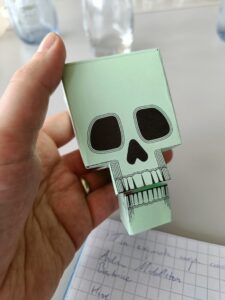
Learning what a mandible is was a result, but so was the reflection that crafting and building activities can be useful for teaching in two respects. The first, is that they provide a context to discuss the object of the crafting (in this case, anatomy), and the second is that sometimes it’s easier to engage your eyes, ears and mind with a subject if your hands are busy snipping a skull out of a sheet of paper.
After that, more podcasting, chatting with the fab conference folk, and then a mad evening of persuading my work laptop to let me edit audio so I could publish the first of the daily podcast digests. Long day!
Day 2
It’s not legal advice, but it’ll have to suffice
Day 2 started with Jane Secker and Chris Morrison’s amazing multimodal cabaret keynote, a high energy and highly playful whistle-stop tour through their madcap approaches to Copyright education. We were treated to live music, a fierce competition of physical endurance, some fabulous skits and four lightspeed costume changes, while being introduced to the podcasts, conferences, card games and advice that Jane and Chris use to make learning about Copyright engaging and accessible. The Copyright Waffle theme tune in particular ended up being quite the earworm.
Building on the themes of the first day, I was struck by the freedom with which Jane and Chris had approached this project, and how much of themselves they had put into it. They bring their musical, comic and game design skills together with a subject they’re deeply interested in and communicate that passion in a way that makes you want to know more.
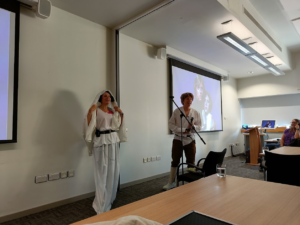
We ended up having a really interesting conversation around one of my own Copyright questions the following day over breakfast, and it’s prompting me to record something with them later on in the year to explore it further.
You can find out more about the fab stuff Jane and Chris have put together over at their site Copyright Literacy. You’ll also find an interview with them, with a live music performance, in the accompanying conference-in-a-pod.
Twine time
Next up was Nick Feather’s session on Narrative Approaches to Learning, a quick introduction to using classic narrative structures to teach using the TWINE Open Source interactive storytelling tool. I’ve dabbled with it myself in the past, but found the storytelling approach a neat framework to hang it off, in a ‘choose your own adventure’ style that works both as a piece of education and a story.
I came away with a reminder of the four components to consider in edu-storytelling: character, setting, goal and obstacle – with the goals and obstacles in particular being ideal places to slip in your teaching moments. It’s a handy shorthand that I’ll look to use in the next edu-games I prototype.
Such meme, many wow
Freshly Twined, I stepped into John Parkin’s session on creating memes to develop conceptual understanding. I love a good meme. John showed us how he’d used the medium to engage his students, develop their visual skills, and get them to demonstrate conceptual understanding by re-fitting it to a meme format.
Memes themselves are an interesting format, as they often use an underlying metajoke to which the additional layer of user created joke is added. As anyone who has tried to sit down and write an education joke before knows, it’s not easy. Turning the various components around as you try to get them to fit in to a joke format can often prompt you to question your own understanding. I’ve had a bash myself in the past and found it rewarding, but the brevity (and information density) of a meme is much more appealing. It’s certainly something I’ll try and do more of myself going forwards, while playfully jumbling up new ideas.
From there, to other sessions – and then more podcast recording in our cosy booth, followed by another flurry of editing and publishing of the day’s content. We all watched Back to the Future that evening, munching away happily on movie food and engaging with parts of the film with a grab bag full of daft goodies. Then editing, publishing and to bed!
Day 3
No more talking heads
The final day started with another flurry of recordings before lunch – and then over to the final sessions. Stephen Caspar’s playful approach to video and media creation in education and academic resonated for me. He talked through a range of techniques and approaches that could be introduced to video content. He was frank about the development time needed, and then challenged us as groups to follow a storyboarding approach to present a playful and engaging take on a piece of subject matter expertise.
Something our group nearly stumbled on was the learning outcome itself. We found that unless you’ve really pinned that down it’s hard to develop a coherent idea. While this shouldn’t have come as a surprise, it’s another useful reminder that if something isn’t working in design it’s best to check the foundations first.
Stephen had a smashing matrix of creative ideas to try to spice up videos, and I’m gutted that I failed to capture it (@Stephen if you’re reading this, can you forward me the slides please?). I did manage to snap one slide in particular though:

I was struck that Mark Childs and I had (through trial and a lot of error) found these same elements to be useful in our own approach to playful education content on the podcast. I hadn’t previously considered them as components, and can now look at some times where we’ve strayed from our format and found that things haven’t quite worked as we’d planned. There’s plenty more meat to chew off this particular bone, but perhaps that’s best served in another post at another time.
Comedy meets coaching
My final parallel session was Claire Ashworth’s ‘When comedy met coaching’, a high energy (and goodness knows where we found it at this point of day 3, we were all running on fumes!) hands on bash at using improv comedy warm-ups and techniques to improve our active listening skills in coaching.
As someone who’s spent what feels like 75% of the last two and a half years in one long MS Teams meeting, it was a shock to the system to be actively engaged with a large group of people in the same space, and the approaches Claire demonstrated really end up tuning you in with the other people in the space – and give them your full and active attention. I’d used several of these techniques myself in previous lives (a long stint of am-dram, and my degree in drama, film and television), but I hadn’t ever thought to use them in a professional context. Something that will bubble away at the back of my brain over the next few months will be how I can adapt some of the techniques within video calls, which account for more of my practice than I’d like.
Change the game
Last, but by no means least, the third and final keynote of the conference was p resented by the effervescent Professor Sylvester Arnanb who took us through a dizzying variety of the initiatives and projects he’s founded, been involved in and given a darn good shaking. Sylvester may well be one of the most intimidatingly brilliant creatives I’ve ever come across, with the Game Changers initiative very much being the big shiny diamond in his achievement crown. This initiative, operating out of Coventry University, is a hybrid open game design course and community, looking at practical ways to implement playful approaches in academic contexts. If that tag line doesn’t hook you then I don’t know what will.
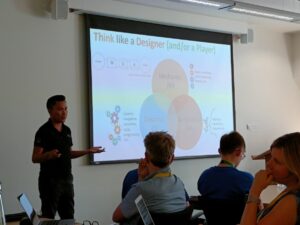
Something Sylvester discussed, which I felt really pulled together some of the threads of the conference, was how play and games (in education) still need to be grounded in pedagogy. What is the learning outcome or learning gap, how will this game mechanic or playful activity support it? What are the verbs, how are they connecting? How are we tracking change, and building in reflection? As with all learning activity, these must still be the foundational.
He also reminded us that despite play often lining up with gut feelings, good pedagogy is supported by evidence and research. Sylvester’s own list of publications could fill a shed, and his call to action to identify gaps in literature and attack them encouraged us not to forget that, in education, play is serious business.
I cheekily recorded Sylvester’s keynote in what I can only shamefully describe as less than ideal audio conditions (a Zoom H2n halfway down the room, somehow picking up multiple layers of echo), but it doesn’t do a great job of capturing the full weight of his points, as he accompanied his talk with a rather rich slide deck. One of my post-conference resolutions is to drop Sylvester an email and see if I can persuade him to record a podcast with me, so we can dig in a bit deeper.
Final thoughts
Playful Learning was a heck of a conference. It brought together creative, energetic and playful educators and created a space where madcap learning, high energy and a lot of laughter was the norm. In a wonderfully meta way, the conference was in itself a great example of playful learning. My hat goes off to the organisers and crew for the huge amount of thought, work and curation that went into everything feeling frictionless, playful and inclusive. If you’re zigging while everyone else is zagging, then this might be the place for you. It’s a community of zig. Mark and I were both touched and chuffed to get a thank you in the conference closing ceremony, and the touching gift of the neon crew shirts I had been coveting since day 1.
We recorded a mountain of material, a selection of which you’ll find in the conference-in-a-pod, with the rest being edited and published over the course of the next few months. Fitting this alongside the conference was exhausting, but incredibly rewarding. Mark and I both have a touch of the shy about us, and having a structured, purposeful way to engage with the pick-n-mix of brilliant folk at the conference was a great way for us to engage.
As the tea leaves of experiences filter through the hot water of reflection, I’d like to share some final thoughts that have brewed around translating playfulness in to my own practice.
- Rules are like pens – If they don’t work, throw them out. And not just the writteny downy ones, but the odd social and professional rules. Like not writing ‘writteny downy’ in a professional blog post.
- Question the assumptions rules are derived from – Does a rule or structure I’ve used or imposed stem from a fundamental misassumption based around my own ideals? In particular, is an assumption of perceived challenge going to be a hurdle for some, and a mountain for others?
- Take more opportunities to bring play into practice – Exquisite corpse, anatomical origami, memes, twine and Copyright cabarets are all a reminder that if you’ve positioned them right then play in its many forms can be an engaging and effective way to learn and teach. It can also help your bring your own authentic self in to your practice, pulling your passions and confidence forward to make the experience of learning and teaching itself better for you. Your students and audiences will benefit from it too, because there’s something infectious (now there’s a loaded term in 2022…stick with me) about having a good time.
- Don’t forget the pedagogy, doofus – While skipping around in the metaphorical candy store of learning, pulling fistfuls of playful approaches and games off the shelves – don’t forget that pedagogy must still be the foundation. Work your way up from learning outcomes as you would with any activity, align it to your curriculum, and select playful tools that match what and how you’re trying to teach.
- Evidence – Add to the growing pile of literature by evaluating your playful approaches, reflecting on them and sharing the results with the wider community. If things go well, capture and share it as good practice. If things go terribly then capture it as a witty anecdote and share that as well.
Playful Learning 2023 is from 5th July to 7th July in Leicester. If you’re of a ludic persuasion, or want to bring more playful approaches in to your practice, then I’ll see you there.
